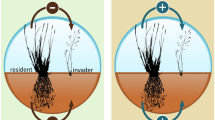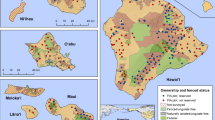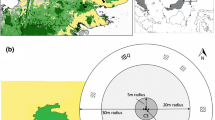Abstract
Multiple factors can affect the process of forest succession including seed dispersal patterns, seedling survival, and environmental heterogeneity. A relatively understudied factor affecting the process of succession is invasions by non-native plants. Invasions can increase competition, alter abiotic conditions, and provide refuge for consumers. Functional traits of trees such as seed size and life history stage may mediate the effects of invasions on succession. We tested the effects of the forest invader Microstegium vimineum on planted and naturally regenerating trees in a multi-year field experiment. We established plots containing nine species of small- and large-seeded tree species planted as seeds or saplings, and experimentally added Microstegium to half of all plots. Over 3 years, Microstegium invasion had an overall negative effect on small-seeded species driven primarily by the effect on sweetgum, the most abundant small-seeded species, but did not affect large-seeded species such as hickory and oak species, which have more stored seed resources. Natural regeneration was over 400% greater in control than invaded plots for box elder, red maple, and spicebush, and box elder seedlings were 58% smaller in invaded plots. In contrast to the effects on tree seedlings, invasion did not affect tree sapling survival or growth. Microstegium may be directly reducing tree regeneration through competition. Invaded plots had greater overall herbaceous biomass in 2006 and 2008 and reduced light availability late in the growing season. Indirect effects may also be important. Invaded plots had 120% more thatch biomass, a physical barrier to seedling establishment, and significantly greater vole damage to tree saplings during 2006 and 2007. Our results show that two tree functional traits, seed size and life history stage, determined the effects of Microstegium on tree regeneration. Suppression of tree regeneration by Microstegium invasions may slow the rate of forest succession and alter tree species composition.






Similar content being viewed by others
References
Armstrong DP, Westoby M (1993) Seedlings from large seeds tolerate defoliation better: a test using phylogenetically independent contrasts. Ecology 74:1092–1100
Baraloto C, Forget PM, Goldberg DE (2005) Seed mass, seedling size and Neotropical tree seedling establishment. J Ecol 93:1156–1166
Berkowitz AR, Canham CD, Kelly VR (1995) Competition vs. facilitation of tree seedling growth and survival in early successional communities. Ecology 76:1156–1168
Braun EL (1950) Deciduous forests of eastern North America, 1st edn. Blackburn Press, Caldwell, New Jersey
Civitello DJ, Flory SL, Clay K (2008) Exotic grass invasion reduces survival of Amblyomma americanum and Dermacentor variabilis ticks (Acari : Ixodidae). J Med Entomol 45:867–872
Claridge K, Franklin SB (2002) Compensation and plasticity in an invasive plant species. Biol Invasions 4:339–347
Collier MH, Vankat JL, Hughes MR (2002) Diminished plant richness and abundance below Lonicera maackii, an invasive shrub. Am Midl Nat 147:60–71
Desteven D (1991) Experiments on mechanisms of tree establishment in old-field succession: seedling emergence. Ecology 72:1066–1075
Droste T, Flory SL, Clay K (2010) Variation for phenotypic plasticity among populations of an invasive exotic grass. Plant Ecol 2:297–306
Ehrenfeld JG (2003) Effects of exotic plant invasions on soil nutrient cycling processes. Ecosystems 6:503–523
Ehrenfeld JG, Kourtev P, Huang WZ (2001) Changes in soil functions following invasions of exotic understory plants in deciduous forests. Ecol Appl 11:1287–1300
Flory SL (2010) Management of Microstegium vimineum invasions and recovery of resident plant communities. Restoration Ecol 18:103–112
Flory SL, Clay K (2009) Invasive plant removal method determines native plant community responses. J Appl Ecol 46:434–442
Flory SL, Clay K (2010) Non-native grass invasion alters native plant composition in experimental communities. Biol Invasions 12:1285–1294
Gill DS, Marks PL (1991) Tree and shrub seedling colonization of old fields in central New York. Ecol Monogr 61:183–205
Gorchov DL, Trisel DE (2003) Competitive effects of the invasive shrub, Lonicera maackii (Rupr.) Herder (Caprifoliaceae), on the growth and survival of native tree seedlings. Plant Ecol 166:13–24
Harms KE, Dalling JW (1997) Damage and herbivory tolerance through resprouting as an advantage of large seed size in tropical trees and lianas. J Trop Ecol 13:617–621
Hartman KM, McCarthy BC (2007) A dendro-ecological study of forest overstorey productivity following the invasion of the non-indigenous shrub Lonicera maackii. Appl Veg Sci 10:3–14
Hartman KM, McCarthy BC (2008) Changes in forest structure and species composition following invasion by a non-indigenous shrub, Amur honeysuckle (Lonicera maackii). J Torrey Bot Soc 135:245–259
Hill JD, Canham CD, Wood DM (1995) Patterns and causes of resistance to tree invasion in rights-of-way. Ecol Appl 5:459–470
Hochstedler WW, Slaughter BS, Gorchov DL, Saunders LP, Stevens MHH (2007) Forest floor plant community response to experimental control of the invasive biennial, Alliaria petiolata (garlic mustard). J Torrey Bot Soc 134:155–165
Horton JL, Neufeld HS (1998) Photosynthetic responses of Microstegium vimineum (Trin.) A. Camus, a shade-tolerant, C-4 grass, to variable light environments. Oecologia 114:11–19
Lahoreau G, Barot S, Gignoux J, Hoffmann WA, Setterfield SA, Williams PR (2006) Positive effect of seed size on seedling survival in fire-prone savannas of Australia, Brazil and West Africa. J Trop Ecol 22:719–722
Leishman MR, Wright IJ, Moles AT, Westoby M (2000) The evolutionary ecology of seed size. In: Fenner M (ed) Seeds: the ecology of regeneration in plant communities, 2nd edn. CAB International, Wallingford, pp 31–57
Levine JM, Vila M, D’Antonio CM, Dukes JS, Grigulis K, Lavorel S (2003) Mechanisms underlying the impacts of exotic plant invasions. Proc R Soc Lond B Biol Sci 270:775–781
Litvaitis JA (2001) Importance of early successional habitats to mammals in eastern forests. Wildl Soc Bull 29:466–473
Marshall JM, Buckley DS, Franklin JA (2009) Competitive interaction between Microstegium vimineum and first-year seedlings of three central hardwoods. J Torrey Bot Soc 136:342–349
Martin PH, Canham CD, Marks PL (2009) Why forests appear resistant to exotic plant invasions: intentional introductions, stand dynamics, and the role of shade tolerance. Front Ecol Environ 7:142–149
Meiners SJ (2007) Apparent competition: an impact of exotic shrub invasion on tree regeneration. Biol Invasions 9:849–855
Moles AT, Westoby M (2004) Seedling survival and seed size: a synthesis of the literature. J Ecol 92:372–383
Myster RW (1993) Tree invasion and establishment in old fields at Hutcheson Memorial Forest. Bot Rev 59:251–272
NOAA and NCDC (2008) National Oceanic and Atmospheric Administration, National Climate Data Center
Olson BE, Wallander RT (2002) Effects of invasive forb litter on seed germination, seedling growth and survival. Basic Appl Ecol 3:309–317
Orr SP, Rudgers JA, Clay K (2005) Invasive plants can inhibit native tree seedlings: testing potential allelopathic mechanisms. Plant Ecol 181:153–165
Orrock JL, Witter MS, Reichman OJ (2008) Apparent competition with an exotic plant reduces native plant establishment. Ecology 89:1168–1174
Ostfeld RS, Manson RH, Canham CD (1997) Effects of rodents on survival of tree seeds and seedlings invading old fields. Ecology 78:1531–1542
Oswalt CM, Oswalt SN, Clatterbuck WK (2007) Effects of Microstegium vimineum (Trin.) A. Camus on native woody species density and diversity in a productive mixed-hardwood forest in Tennessee. For Ecol Manage 242:727–732
Pacala SW, Canham CD, Saponara J, Silander JA, Kobe RK, Ribbens E (1996) Forest models defined by field measurements: estimation, error analysis and dynamics. Ecol Monogr 66:1–43
Rudgers JA, Holah J, Orr SP, Clay K (2007) Forest succession suppressed by an introduced plant–fungal symbiosis. Ecology 88:18–25
Schulz K, Thelen C (2000) Impact and control of Vinca minor L. in an Illinois forest preserve (USA). Nat Areas J 20:189–196
Seiwa K (2000) Effects of seed size and emergence time on tree seedling establishment: importance of developmental constraints. Oecologia 123:208–215
Simao MC, Flory SL, Rudgers JA (2010) Experimental plant invasion reduces arthropod abundance and richness across multiple trophic levels. Oikos. doi:10.1111/j.1600-0706.2010.18382.x
Stinson KA et al (2006) Invasive plant suppresses the growth of native tree seedlings by disrupting belowground mutualisms. PLoS Biol 4:727–731
USDA and NRCS (2005) The PLANTS database. Version 3.5. Data compiled from various sources by Mark W. Skinner. National Plant Data Center, Baton Rouge
Wilsey BJ, Potvin C (2000) Biodiversity and ecosystem functioning: importance of species evenness in an old field. Ecology 81:887–892
Acknowledgments
We thank Dave Civitello for providing insightful comments on a previous version of this manuscript. This project was funded by The Nature Conservancy, a partnership between Indiana University and the USDA Forest Service Hoosier National Forest, and the Joint Fire Science Program (JFSP 08-1-2-01). This experiment complied with the current laws of the United States.
Author information
Authors and Affiliations
Corresponding author
Additional information
Communicated by John Silander.
Rights and permissions
About this article
Cite this article
Flory, S.L., Clay, K. Non-native grass invasion suppresses forest succession. Oecologia 164, 1029–1038 (2010). https://doi.org/10.1007/s00442-010-1697-y
Received:
Accepted:
Published:
Issue Date:
DOI: https://doi.org/10.1007/s00442-010-1697-y




